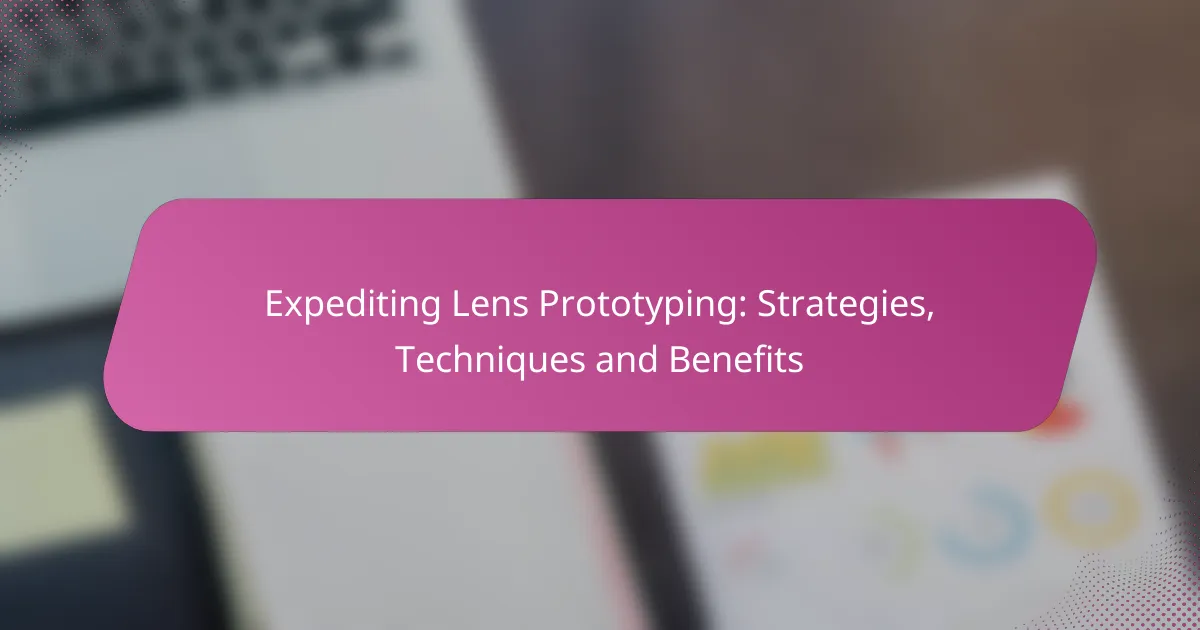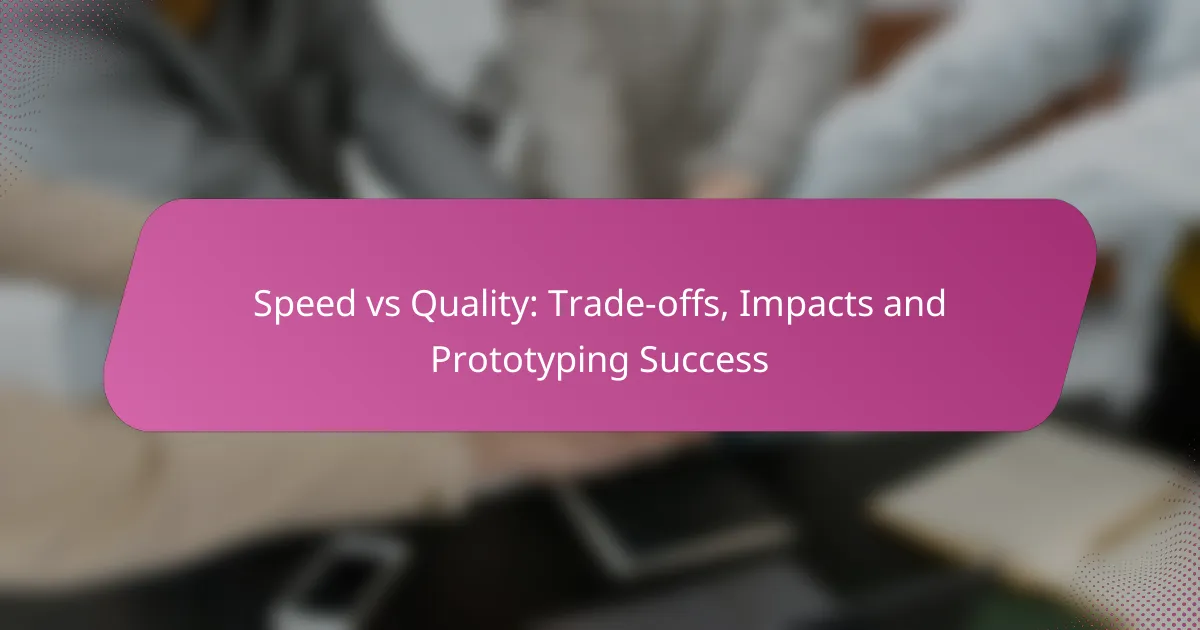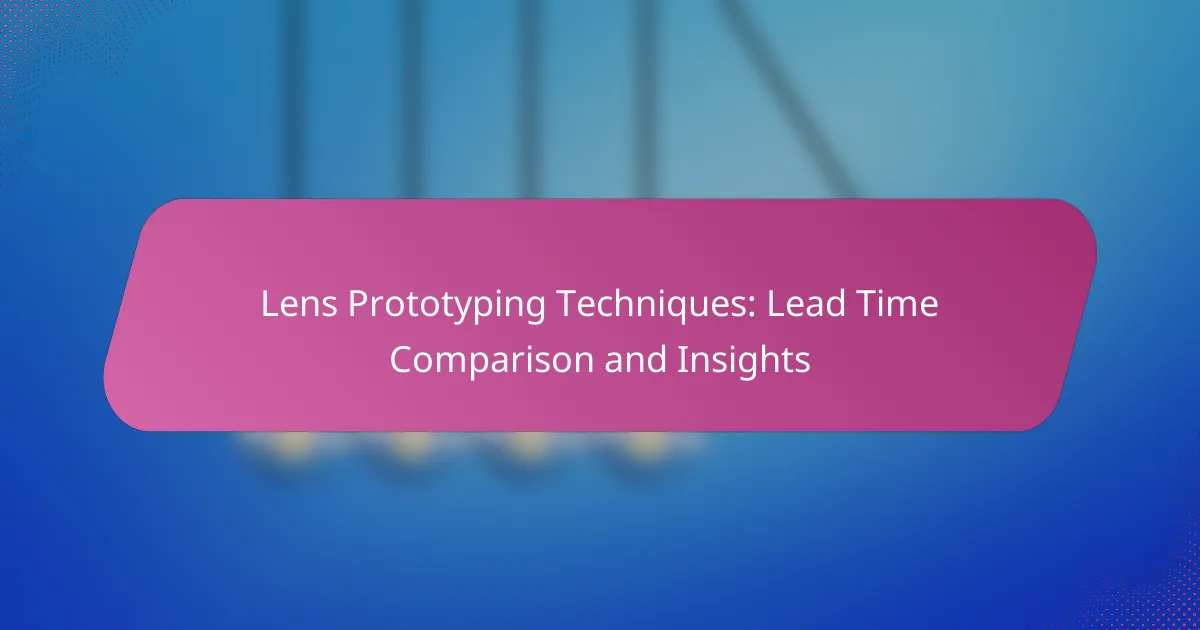Expediting lens prototyping is essential for companies aiming to stay competitive in a fast-paced market. By leveraging advanced technologies and collaborative strategies, such as 3D printing and agile methodologies, developers can significantly shorten the design and testing phases. This not only accelerates product development cycles but also enhances adaptability and reduces costs, allowing for a more responsive approach to market demands.
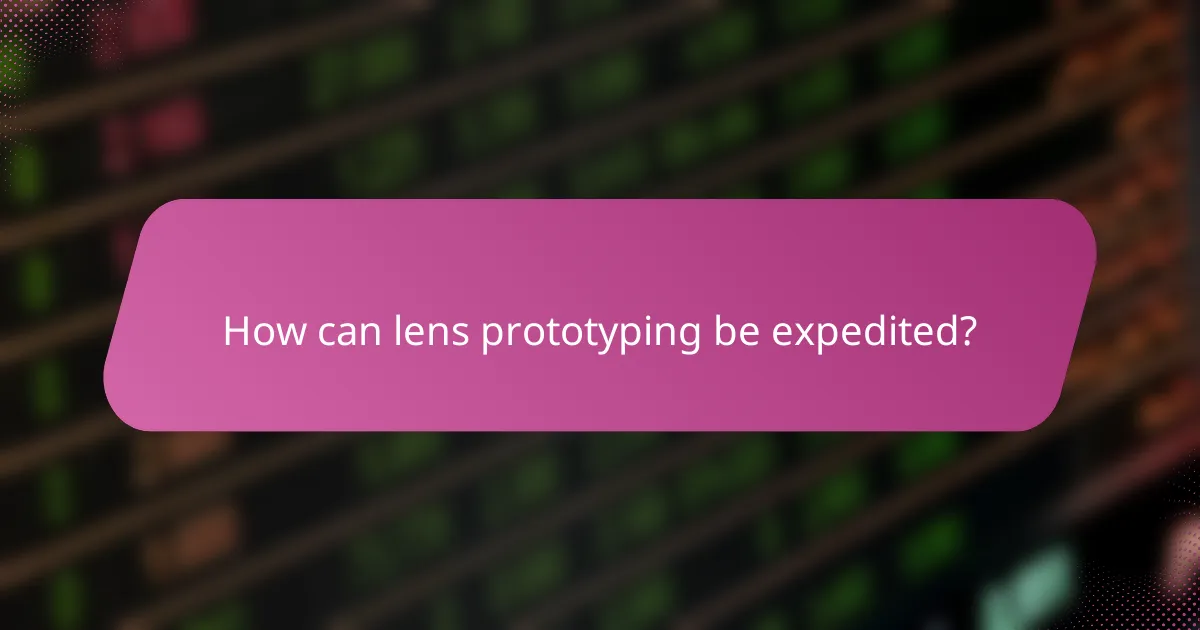
How can lens prototyping be expedited?
Lens prototyping can be expedited through the use of advanced technologies and collaborative strategies that streamline the design and testing processes. By adopting methods such as 3D printing, rapid iteration, software simulations, and partnerships with specialized firms, developers can significantly reduce time-to-market while maintaining quality.
Utilizing 3D printing technology
3D printing technology allows for the rapid creation of lens prototypes, enabling designers to quickly test and iterate on their ideas. This additive manufacturing process can produce complex geometries and customized shapes that traditional methods may struggle to achieve.
Using 3D printing can cut down prototyping time from weeks to just a few days, depending on the complexity of the lens design. For example, a simple lens prototype can be printed in a matter of hours, allowing for immediate testing and feedback.
Implementing rapid iteration techniques
Rapid iteration techniques involve quickly cycling through design modifications based on testing results. This approach encourages frequent prototyping and feedback, which can lead to faster identification of design flaws and improvements.
Employing methods like Agile development can enhance the prototyping process. Teams can set short sprints, typically lasting one to two weeks, to focus on specific design aspects, enabling them to refine prototypes efficiently.
Leveraging software simulation tools
Software simulation tools allow designers to model and analyze lens performance before physical prototypes are created. These tools can simulate optical properties, material behavior, and environmental impacts, providing valuable insights early in the design process.
Using simulation software can save time and resources by identifying potential issues in the design phase. For instance, optical simulation can reveal how light interacts with the lens, helping to optimize designs before moving to physical production.
Collaborating with specialized prototyping firms
Partnering with specialized prototyping firms can enhance the speed and quality of lens development. These firms often have access to advanced technologies and expertise that can streamline the prototyping process.
When selecting a prototyping partner, consider their experience with lens designs and their capabilities in rapid prototyping. A good collaboration can lead to quicker turnaround times and improved prototype quality, ultimately accelerating the overall development timeline.

What are the benefits of expedited lens prototyping?
Expedited lens prototyping offers significant advantages, including faster product development cycles, reduced costs, and greater design adaptability. These benefits enable companies to respond swiftly to market demands and innovate more effectively.
Reduced time-to-market
One of the primary benefits of expedited lens prototyping is the reduced time-to-market. By utilizing advanced techniques such as 3D printing and rapid tooling, companies can create prototypes in a matter of days instead of weeks or months. This acceleration allows businesses to launch products faster, gaining a competitive edge.
To achieve this, teams should focus on iterative design processes and rapid feedback loops. Engaging with stakeholders early can help identify potential issues quickly, further shortening development timelines.
Lower development costs
Expedited lens prototyping can lead to lower development costs by minimizing waste and reducing the number of iterations needed. Traditional prototyping methods often involve significant material and labor expenses, but rapid prototyping techniques can streamline these processes.
For instance, using digital fabrication technologies can cut costs by allowing for precise adjustments without the need for expensive molds. Companies can save tens of percent on development budgets when they adopt these modern approaches.
Enhanced design flexibility
Enhanced design flexibility is another key benefit of expedited lens prototyping. Rapid prototyping allows designers to experiment with various materials and geometries without the constraints of traditional manufacturing methods. This freedom can lead to innovative solutions that better meet user needs.
Moreover, the ability to quickly iterate on designs means that teams can incorporate feedback from testing phases more effectively. This adaptability can be crucial in industries where consumer preferences shift rapidly, ensuring that products remain relevant and appealing.
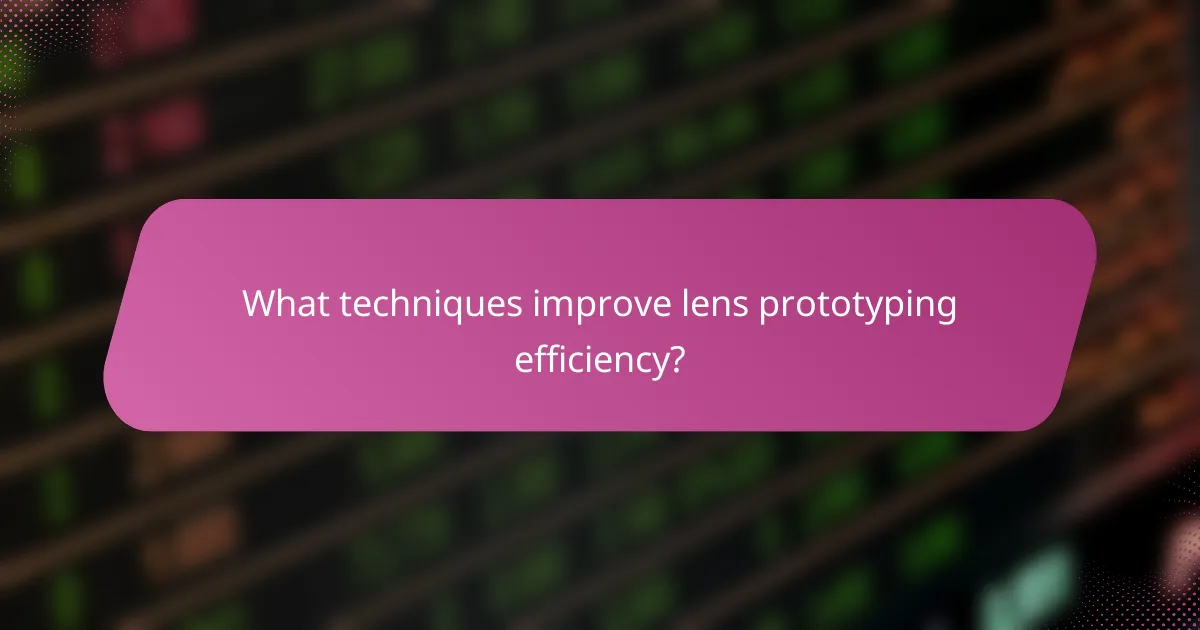
What techniques improve lens prototyping efficiency?
To enhance lens prototyping efficiency, adopting agile methodologies, integrating customer feedback loops, and utilizing modular design approaches are key strategies. These techniques streamline the development process, reduce time to market, and improve product alignment with user needs.
Adopting agile methodologies
Agile methodologies focus on iterative development and flexibility, allowing teams to adapt quickly to changes. By breaking the prototyping process into smaller, manageable sprints, teams can deliver incremental improvements and gather feedback more frequently.
Implementing daily stand-ups and regular reviews can help maintain momentum and ensure alignment among team members. This approach minimizes wasted effort and allows for rapid adjustments based on testing outcomes or market shifts.
Integrating customer feedback loops
Incorporating customer feedback loops into the lens prototyping process ensures that user insights directly influence product development. Engaging customers early and often helps identify their needs and preferences, which can lead to more successful designs.
Consider using surveys, focus groups, or beta testing to gather feedback at various stages. This practice not only enhances product relevance but also fosters customer loyalty by making users feel valued in the design process.
Utilizing modular design approaches
Modular design allows for the creation of interchangeable components, which can significantly speed up the prototyping process. By designing lenses in modules, teams can test individual parts without needing to overhaul the entire system.
This approach also facilitates easier updates and modifications based on feedback or new technologies. For example, if a specific lens coating proves ineffective, only that module needs revision, rather than the entire lens design.
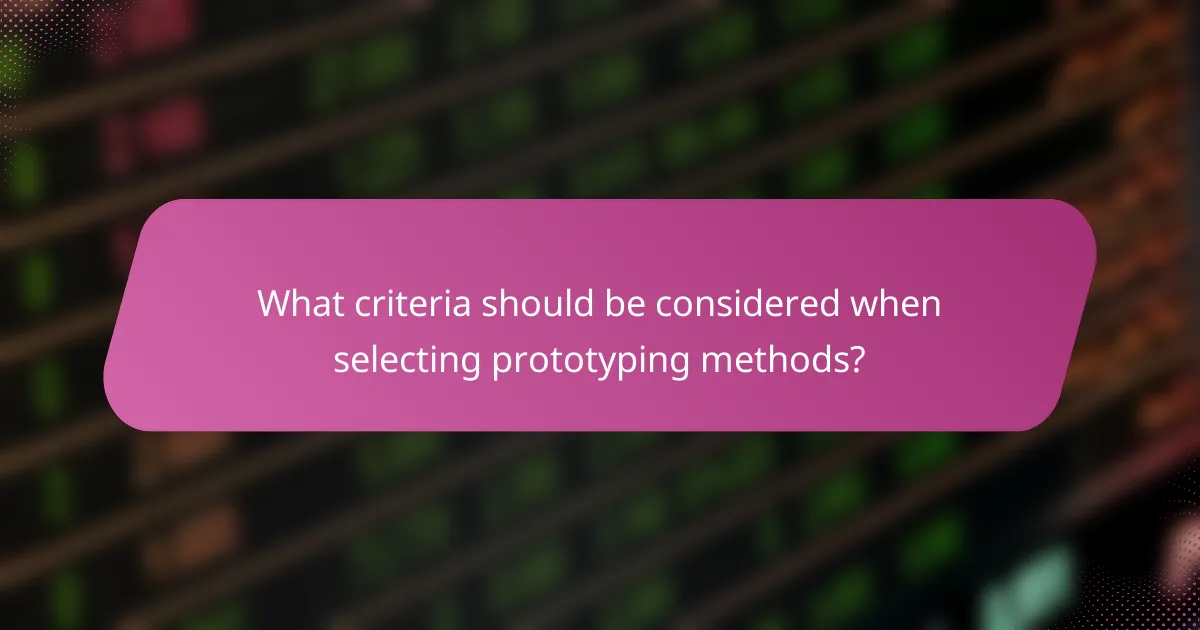
What criteria should be considered when selecting prototyping methods?
When selecting prototyping methods for lens development, consider material compatibility, cost-effectiveness, and speed of production. Each criterion plays a crucial role in ensuring that the prototype meets functional requirements while staying within budget and time constraints.
Material compatibility
Material compatibility is essential for achieving the desired optical properties and durability of the lens prototype. Different prototyping methods utilize various materials, such as polymers, glass, or composites, which can significantly affect the lens’s performance.
Evaluate the specific requirements of your lens design, including refractive index, clarity, and resistance to environmental factors. For instance, if your prototype needs to withstand high temperatures, select materials that can endure such conditions without degrading.
Cost-effectiveness
Cost-effectiveness involves balancing the expenses associated with prototyping methods against the expected benefits. Some methods, like 3D printing, may offer lower initial costs but could require more expensive materials or post-processing steps.
Consider the total cost of ownership, including material costs, labor, and any necessary equipment. For example, traditional glass lens manufacturing may have higher upfront costs but can be more economical for larger production runs due to lower per-unit costs.
Speed of production
Speed of production is a critical factor when time-to-market is a priority. Rapid prototyping methods, such as additive manufacturing, can produce prototypes in a matter of hours, allowing for quicker iterations and testing.
Assess the trade-offs between speed and quality. While faster methods may expedite the development process, they might not always deliver the precision required for high-performance lenses. Establish a timeline that aligns with your project goals while ensuring the prototype meets quality standards.

How does geographic location impact lens prototyping?
Geographic location significantly influences lens prototyping by affecting access to resources, talent, and innovation. Regions with established manufacturing capabilities and research institutions can expedite the prototyping process, leading to faster development cycles and reduced costs.
Access to local manufacturing resources
Being close to local manufacturing resources can streamline the lens prototyping process. Proximity to suppliers of raw materials and components can reduce lead times and shipping costs, which is crucial for rapid iterations. For instance, a company in a manufacturing hub may receive components within days, while one located further away might face delays of weeks.
Additionally, local manufacturing facilities often have established relationships with prototyping firms, which can facilitate quicker adjustments and customizations. Companies should evaluate the availability of local suppliers and consider forming partnerships to enhance their prototyping capabilities.
Proximity to innovation hubs
Being near innovation hubs provides access to cutting-edge research and a network of experts in lens technology. These areas often host universities, research institutions, and tech companies that can offer collaboration opportunities, funding, and knowledge sharing. For example, regions like Silicon Valley or Munich are known for their vibrant tech ecosystems that foster rapid advancements in optical technologies.
Moreover, proximity to these hubs can enhance talent acquisition, as skilled professionals are more likely to be attracted to areas with a strong focus on innovation. Companies should consider relocating or establishing satellite offices in these regions to leverage the benefits of being close to innovation-driven environments.
